RBSE Class 11 Biology Important Questions Chapter 2 Biological Classification
Rajasthan Board RBSE Class 11 Biology Important Questions Chapter 2 Biological Classification Important Questions and Answers.
Rajasthan Board RBSE Solutions for Class 11 Biology in Hindi Medium & English Medium are part of RBSE Solutions for Class 11. Students can also read RBSE Class 11 Biology Important Questions for exam preparation. Students can also go through RBSE Class 11 Biology Notes to understand and remember the concepts easily.
RBSE Class 11 Biology Chapter 2 Important Questions Biological Classification
Multiple Choice Type Questions
Question 1.
Which of the following are found in extreme saline conditions?
(a) Achaebacteria
(b) Eubacteria
(c) Cyanobacteria
(d) Mycobacteria
Answer:
(a) Achaebacteria

Question 2.
Viroids differ from viruses having:
(a) DNA molecules with protein coat
(b) DNA molecules without protein coat
(c) RNA molecules with protein coat
(d) RNA molecules with protein coat
Answer:
(d) RNA molecules with protein coat
Question 3.
Which among the following are the smallest living cells, known without definite cell wall, pathogenic to plants as well as animals and can survive without oxygen?
(a) Bacillus
(b) Pseudomonas
(c) Mycoplasma
(d) Nostoc
Answer:
(c) Mycoplasma
Question 4.
The primitive prokaryotes responsible for the production of ‘biogas’ from the dung of ruminant animals include the:
(a) thermoacidophiles
(b) methanogens
(c) eubacteria
(d) halophiles
Answer:
(b) methanogens
Question 5.
Which of the following statements is wrong for viroids?
(a) They are smaller than viruses
(b) They cause infections
(c) Their RNA is of high molecular weight
(d) They lack a protein coat
Answer:
(c) Their RNA is of high molecular weight
Question 6.
Which of the following statements is wrong?
(a) Golden algae are also called desmids.
(b) Eubacteria are also called false bacteria.
(c) Phycomycetes are also called algal fungi.
(d) Cyanobacteria are also called blue green algae.
Answer:
(b) Eubacteria are also called false bacteria.
Question 7.
Methanogens belong to:
(a) eubacteria
(b) archaebacteria
(c) dinoflagellates
(d) slime moulds
Answer:
(b) archaebacteria
Question 8.
Chrysophytes, euglenoids, dinoflagellates and slime moulds are included in the kingdom:
(a) protista
(b) fungi
(c) animalia
(d) monera
Answer:
(a) protista
Question 9.
Select the wrong statement:
(a) Cell wall is absent in Animalia.
(b) Protista have photosynthetic and heterotrophic modes of nutrition.
(c) Some fungi are edible.
(d) Nuclear membrane is present in Monera.
Answer:
(d) Nuclear membrane is present in Monera.
Question 10.
Select the wrong statement:
(a) The walls of diatoms are easily destructible.
(b) Diatomaceous earth is formed by the cell walls of diatoms.
(c) Diatoms are chief producers in the oceans.
(d) Diatoms are microscopic and float passively on water.
Answser:
(d) Diatoms are microscopic and float passively on water.

Question 11.
Which of the following would appear as the pioneer organisms on bare rocks?
(a) Liverworts
(b) Mosses
(c) Green algae
(d) Lichens
Answer:
(d) Lichens
Question 12.
Out of major components of cell wall of most fungi is:
(a) peptidoglycan
(b) cellulose
(c) hemicellulose
(d) chitin
Answer:
(d) chitin
Question 13.
Which one of the following is wrong for fungi?
(a) They are eukaryotic.
(b) All fungi possess a purely cellulosic cell wall.
(c) They are heterotrophs.
(d) They are both unicellular and multicellular.
Answer:
(b) All fungi possess a purely cellulosic cell wall.
Question 14.
Chromatophores take part in:
(a) photosynthesis
(b) growth
(c) movement
(d) respiration
Answer:
(a) photosynthesis
Question 15.
Select wrong statement:
(a) The viroids were discovered by D.J. Ivanowski.
(b) WM Stanley showed that viruses could be crystallised.
(c) The term ‘contagium vivum fluidum’ was coined by M.W. Beijerinek.
(d) Mosaic disease in Tobacco and AIDS in human being are caused by viruses.
Answer:
(a) The viroids were discovered by D.J. Ivanowski.

Question 16.
The structures that help some bacteria to attach to rocks and/or host tissues are:
(a) rhizoids
(b) fimbriae
(c) mesosomes
(d) hold fast
Answer:
(b) fimbriae
Question 17.
The imperfect fungi which are decomposers of litter and help in mineral cycling belong to:
(a) Deuteromycetes
(b) Basidio mycetes
(c) Phycomycetes
(d) Ascomycetes
Answer:
(a) Deuteromycetes
Question 18.
Archaebacteria differ from bacteria in:
(a) cell membrane structure
(b) mode of nutrition
(c) cell shape
(d) mode of reproduction
Answer:
(a) cell membrane structure
Question 19.
Which of the following shows coiled RNA strand and capsomeres?
(a) Polio virus
(b) TMV
(c) Measles virus
(d) Retrovirus
Answer:
(b) TMV
Question 20.
Pigment containing membranous extensions in some cyanobacteria are:
(a) heterocysts
(b) basal bodies
(c) pneumatophores
(d) chromatophores
Answer:
(d) chromatophores
Question 21.
Which of the following shows coiled RNA strand and capsomeres?
(a) Polio virus
(b) Tobacco mosaic virus
(c) Measles virus
(d) Retrovirus
Answer:
(b) Tobacco mosaic virus
Question 22.
Pigment containing membranous extensions in cyanobacteria are:
(a) heterocysts
(b) basal bodies
(c) pneumatophores
(d) chromatophores
Answer:
(d) chromatophores
Question 23.
Which of the following are likely to be present in deep sea water:
(a) Archaebacteria
(b) Eubacteria
(c) Blue green algae
(d) Saprophytic fungi
Answer:
(a) Archaebacteria
Question 24.
The cyanobacteria are also referred to as:
(a) protists
(b) golden algae
(c) slime moulds
(d) blue - green algae.
Answer:
(c) slime moulds
Very Short Answer Questions
Question 1.
Name the two kingdoms of organisms proposed by Linnaeus.
Answer:
Plantae and Animalia.

Question 2.
Who introduced the 5 kingdom system of classification.
Answer:
RH Whittaker.
Question 3.
Give names of the 5 kingdoms proposed by Whittaker.
Answer:
Monera, Protista, Fungi, Plantae and Animalia.
Question 4.
What are protists?
Answer:
Unicellular eukaryotic organisms are called protists.
Question 5.
In which kingdom are the viruses placed?
Answer:
None.
Question 6.
What are eukaryotic organisms?
Answer:
Organisms having membrane bounded nucleus and cell organelles are called eukaryotic organisms.
Question 7.
On what basis the fungi were earlier included in the kingdom plantae?
Answer:
Fungi possess cellwall and are non-motile like the plants. Therefore fungi were included in the kingdom plantae earlier.
Question 8.
What are prokaryotic organisms?
Answer:
Cellular organisms devoid a membrane around the genetic material are called prokaryotic organisms.
Question 9.
To which kingdom do liverworts and mosses belong?
Answer:
Kingdom plantae.
Question 10.
Mention the main reserve food in plants and animals.
Answer:
Starch in plants and Glycogen in animals.
Question 11.
What is mixotrophic nutrition? Give an example.
Answer:
Double mode of nutrition (i.e., holophytic and saprophytic) is called mixotrophic nutrition. It is found in Euglena.
Question 12.
What is the chemical compound present in bacterial cellwall?
Answer:
Peptidoglycan.
Question 13.
Name the protein which is present in the bacterial flagella.
Answer:
Flagelin.
Question 14.
Name the group of bacteria commonly called ray fungi.
Answer:
Actinomycetes are commonly called ray fungi.
Question 15.
What are smallest living organisms?
Answer:
PPLO (Pleuropneumonia like organisms) are considered as smallest living organisms.

Question 16.
Mention the three major groups of kingdom protista.
Answer:
Protistan algae, slime moulds and protozoan protists are the three major groups of kingdom protista.
Question 17.
Cellwall in fungi is made up of which substances?
Answer:
Chitin and fungal cellulose.
Question 18.
Mention the reserve foods in fungi.
Answer:
Glycogen and oil granules.
Question 19.
Which group of fungi is called sac fungi?
Answer:
Ascomycetes is called sac fungi.
Question 20.
Which group of fungi is called club fungi?
Answer:
Basidiomycetes is called club fungi.
Question 21.
Name the two components of lichens.
Answer:
Algae and fungi.
Question 22.
What is called algal component of lichens?
Answer:
Phycobiont.
Question 23.
What is called fungal component of lichens?
Answer:
Mycobiont.
Question 24.
Why are some fungi categorised under “fungi imperfecti”?
Answer:
Because they lack perfect (sexual) stages in their life cycle.
Question 25.
What type of genetic material present in TMV (Tobacco Mosaic Virus)?
Answer:
Single stranded RNA molecule present as a genetic material in Tobacco mosaic virus.
Question 26.
Who coined the term virus.
Answer:
Dmitri Ivanowsky coined the term virus.
Question 27.
Name the RNA particle similar to that of virus.
Answer:
Viroid.
Question 28.
What do you mean by naked DNA?
Answer:
The DNA molecule not surrounded with histone proteins is called naked DNA.
Question 29.
What are bacteriophages?
Answer:
Viruses that attack bacteria are called bacteriophages.

Question 30.
Why are lichens said to be pioneer plants on bare rocks?
Answer:
Many crustose lichens grow on clean bare rocks and initiate a xerarch plant succession. Therefore they are called pioneer plants on bare rocks.
Short Answer Type Questions - I
Question 1.
What is the principle underlying the use of cyanobacteria in agricultural fields for crop improvement?
Answer:
Cyanobacteria are used in agricultural crop improvement because of their ability to fix atmospheric nitrogen and make it available to crop plants. This improves the yield of the crops and also reduces the cbst of application of nitrogen fertilizers, e.g., Nostoc and Anabaena.
Question 2.
Polluted water bodies have usually very high abundance of plants like Nostoc and Oscillitoria. Give reasons.
Answer:
Polluted water bodies possess high algal growth due to the presence of nutrients in them. These nutrients increase the rapid growth of aquatic plants i.e., Algae especially Nostoc and Oscillitoria etc., and around in the formation of their colonies. These colonies are generally surrounded by a gelatinous sheath and further leads to be formation of blooms in water bodies.
Question 3.
Are chemosynthetic bacteria autotrophic or heterotrophic?
Answer:
Chemosynthetic bacteria are capable of oxidising various inorganic substances such as nitrates, nitrites and use the energy released for their ATP production. So they are considered as autotrophs and not heterotrophs.
Question 4.
A virus is considered as a living organism and an obligate parasite when inside a host cell. But virus is not classified along with bacteria or fungi.
What are the characters of virus that are similar to non - living objects?
Answer:
Viruses are considered as living when they are inside a host cell but outside the host cells they are referred to as non - living objects because of the following reasons:
- Their inert nature.
- Their inability to reproduce.
- Lack of cellular organisation.
- Their inability for growth and cell division.
Therefore, viruses are considered a connective link between living and non - living organisms.
Question 5.
Name the important groups of organisms included in prokaryotes.
Answer:
The prokaryotes includes Bacteria, Cyanobacteria, Mycoplasmas, Rickettsias, Actinomycetes and Archaebacteria.
Question 6.
Give suitable examples of the following:
(a) A free living nitrogen fixing bacteria.
(b) A non - toxic fast growing cyanobacteria used to obtain single cell protein (SCP).
(c) A cyanobacteria used in the reclamation of ‘usar land’ (sterile alkaline soil).
(d) A microorganism causes mosaic disease of Tobacco plant.
Answer:
(a) Azotobacter
(b) Spirulina
(c) Aulosira fertilissima
(d) Tobacco mosaic virus (TMV)
Question 7.
What are conidia? How they are different from sporangiospores?
Answer:
Conidia are special type of asexual spores borne singlely or in chains. On special branches of hyphae called conidiophores. On the otherhand sporangiospores are borne inside the sporangia. They are usually produced in large numbers.
Question 8.
What do you mean by holophytic and holozoic modes of nutrition?
Answer:
Holophytic nutrition: The mode of nutrition in which the organisms synthesize their own organic food from CO2 and H2O with the help of photosynthesis pigments such as chlorophyll by the use of sunlight as the external source of nutrition is palled holophytic mode of nutrition. For example - blue - green algae and other higher plants.
Holozoic nutrition: In this mode of nutrition the organisms capture, ingest, digest and assimilate other animals and plants. For example - Amoeba, Humans etc.

Question 9.
Write short notes on the following:
(a) Mixotrophic nutrition
(b) Nuclear dimorphism.
Answer:
(a) Mixotrophic Nutrition: In this type of mode of nutrition the protists obtain their food by more than one method at the same or at different times due to change in environmental conditions. For example, Euglena takes its nutrition by holozoic, holophytic and saprobic modes of nutrition.
(b) Nuclear dimorphism: Presence of two morphologically distinct types of nuclei in an organism is called nuclear dimorphism. For example, Paramoecium contains a large nucleus (macrohucleus) and a small nucleus (micronucleus).
Question 10.
What are viruses. Draw a labelled diagram of Tobacco mosaic virus.
Answer:
Virurses are ultramicroscopic, non-cellular, highly infectious agents that multiply only introcellularly inside the living host cells without involving growth and division. Outside the living cells they behave as inert particles. They are nucleoproteins having one or more nucleic acid molecules either DNA or RNA enclosed in a coat of protein or lipoprotein.
The name virus that means venom or poisonous fluid was given by Dmitri Ivanowsky (1892) recognised certain microbes as casual organism of mosaic disease of tobacco. These were found to be smaller than bacteria because they passed through bacteria proof filters. M.W. Beijrinck (1898) demonstrated that the extract of the injected plant of tobacco could cause infection in healthy plants and called the fluid contagium vivum fluidum (infectious living fluid). W.M. Stanley (1935) showed that viruses could be crystallised and crystals consist largely proteins. Viruses are considered as obligate parasites.
Viruses are highly pathogenic and cause infectious diseases in animals and plants. They cause infection in the host cells by means of nucleic acids,
- In general viruses that infect plants have single stranded RNA
- viruses that infect animals have either single or double stranded RNA or double stranded DNA and
- Bacterial viruses or bacteriophages (viruses that infect the bacteria) are usually double stranded DNA viruses.
Some viruses possess an outer thin loose covering called envelop composed of proteins, lipids and carbohydrates. The smaller subunits of envelope are called peptomere. The protein coat of viruses is called capsid made of small subunits called capsomeres protects the nucleic acid. These capsomeres are arranged in helical or polyhedral geometric forms.
Viruses cause diseases like mumps, small pox, herpes and influenza. AIDS in humans is also caused by a virus Human Immunodeficiency Virus (HIV). In plants the symptoms can be mosaic formation, leaf rolling and curling, yellowing and vein clearning, dwarfing and stunted growth.
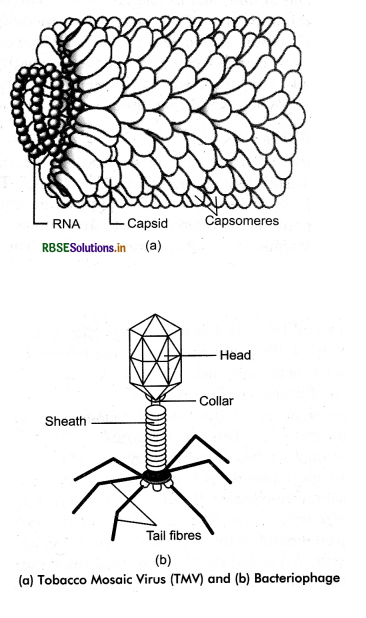
Question 11.
Give an account on viroids.
Answer:
Viroid was discovered by T.O. Diener in 1971 as a new infectious agent that was smaller than viruses and caused potato spindle tuber disease. It was found to be a free RNA. It lacked the protein coat that is found around the viruses, hence they were called viroids. The RNA of the viroid was of low molecular weight.
Question 12.
Give an account on prions.
Answer:
In modern medicine certain infectious neurological diseases were found to be transmitted by an agent consisting of abnormally folded protein. The organism was similar in size of viruses. These microorganisms were called prions. The most notable diseases caused by prions are bovine spongiform encephalopathy (BSE) commonly known as mad cow disease in cattle and its analogue varient Cr. Jacob disease (CJD) in humans.
Question 13.
What are lichens? How can they be classified on the basis of their morphology.
Answer:
The Lichens are symbiotic associations i.e., mutually useful associations between algae and fungi. The algal component of lichen is called phycobiont and fungal component as mycobiont which are autotrophic and heterotrophic in nature respectively. The fungus provides the structural covering that protects alga from unfavourable conditions i.e., drought, heat etc. It also traps the moisture from the atmosphere and anchors the lichens to be rock, tree bark, leaves and other similar supports. The algae prepares organic food by the process of photosynthesis from CO2 in presence of sunlight. If the algal component is a cyanobacterium it fixes atmospheric nitrogen along with preparation of organic food.
There are more than 400 genera and 15000 species of lichens. They are perennial and grow in very wide habitats. The lichens which grow on stones are called saxcoles and those growing on barks are called corticoles. The lichens do not grow in polluted areas therefore, they are very good pollution indicators. Lichens are highly pigmented and may be bluish, green, gray, yellow, orange, red and brown in colour.
Lichens are of following types:
- Ascolichens: When the algal partner belongs to ascomycetes.
- Basidiolichen: When the fungal partner belongs to basidiomycetes.
- Lichens Imperfecti: When the fungal component belongs to fungi imperfecti.
On the basis of morphology lichens are of following types:
- Crustose Lichens: They have flattened thalli closely attached to the substratum and look like crusts, e.g., Graphis, Haematomma Verrucaria, Lecanora, Rhizocarpon etc.
- Foliose Lichen: They have flat, dorsiventral expanded leaf like appearence of thalli with irregular margins. They are attached with substratum by means of rhizoid (rhizoid like structures) e.g., Physcia, Parmelia, Peltigera, Gryophora etc.
- Fruticose Lichen: They are much branched and bushy in appearance. They may be erect or pendent and attached to the substratum by means of basal ends e.g., Usnea, Cladonia, Ramalia, Alectoria etc.
Lichens are pioneers of rock vegetation and establish themselves on bare rocks, cliffs, mountain and new terrains.
Question 14.
Mention the types of lichens on the basis of fungal component.
Answer:
Lichens are of following types:
- Ascollchens: When the fungal partner belongs to class ascomycetes then lichens are called ascolichens.
- Basidiolichens: When the fungal partner belongs to class Basidiomycetes then lichens are called Basidiolichens.
- Lichens imperfecti: When the fungal component belongs to fungi imperfecti then the lichens are called lichens imperfecti.

Question 15.
What are the physiological relationships between the algal and fungal components of lichens?
Answer:
The fungal component holds water, provides protection and ideal housing to algal component. The algal component provides organic food to fungal component. If the algal component is capable of fixing atmospheric nitrogen it supplies fixed nitrogen to fungal component. This type of physiological relationship between algae and fungi of lichen is termed as mutualistic symbiotic association.
Short Answer Type Questions - II
Question 1.
Draw a labelled diagram of any protozoan.
Answer:
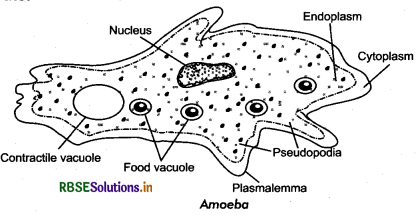
Question 2.
Draw a labelled diagram (electron microscopic structure) of a bacterial cell.
Answer:
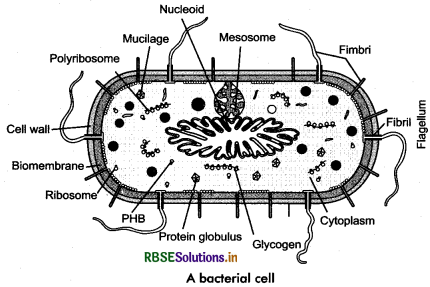
Question 3.
What are mycoplasmas?
Answer:
Mycoplasmas are the smallest self-replicating organisms currently known to science. Common in nature, they are a group of simple bacteria characterized by a lack of a cell wall and a small genome. Many Mycoplasma species are found in the respiratory tracts of animals, where they have been associated with disease. For example, Mycoplasma pneumoniae is a leading cause of respiratory infections in humans (1).

Question 4.
What are cyanobacteria? Draw a labelled diagram of a filamentous cyanobacterium.
Answer:
Cyanobacteria are photosynthetic organisms. They are prokaryotes and are also referred to as blue - green algae. They contain chlorophyll ‘a’ like plants and are also capable of nitrogen fixation. E.g. Anabaena, Nostoc.
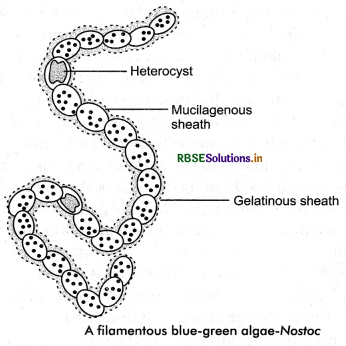
Question 5.
Diatoms are also called as ‘pearls of ocean’. Why? What is diatomaceous earth?
Answer:
Diatoms and desmids are grouped under chrysophytes of kingdom monera. They live in fresh water as well as in marine environment. Diatoms are microscopic, unicellular organisms of various colours and diverse forms. They may be circular, rectangular, triangular, elongated, spindle shaped, half moon shaped and filamentous. Their cellwall is chiefly composed of cellulose impregnated with glass like silica. It shows sculpture and ornamentations.
Diatoms have left behind large amount of cellwalls deposits in their habitats. This accumulation over billions of years is referred to as diatomaceous earth or diatomite. Which is mined and used in various industries. The material obtained from diatomaceous earth is used in polishing and Alteration purposes of different products.
Question 6.
Cyanobacteria and heterotrophic bacteria have been clubbed together in eubacteria of kingdom Monera as per the ‘five kingdom classification’ even though the two are vastly different from each other. Is this grouping of the two types of taxa in the same kingdom justified? If so, why? Discuss the cellular composition of cyanobacteria and heterotrophic bacteria that make them introduced in eubacteria.
Answer:
Although the two are vastly different from each other, they still bear some common characteristics, on the basis of which they are clubbed together in eubacteria of kingdom Monera. These characteristics are as follows:
- Both the groups do not possess well defined nucleus.
- Nucleus lacks nuclear membrane and nucleolus.
- Genetic material (DNA) lies freely in their cytoplasm.
- They contain 70s type of ribosomes.
Question 7.
Neurospora and ascomycetes fungus has been used as biological tool understand the mechanism of plant genetics much in the same way as Drosophila has been used to study animal genetics. What makes Neurospora so important as a genetic tool?
Answer:
Neurospora was selected to be a very good tool in genetics because it can be grown easily under laboratory conditions by providing minimal medium like inorganic salts, carbohydrates source and vitamin (biotin) under X - rays treatment. The mutations can be easily introduced in the fungal cells and meiotic cell division can be seen easily.
Question 8.
Fungi are cosmopoliton, write the role of fungi in your daily life. Discuss the role of fungi with respect to its economical importance to humans.
Answer:
Role of fungi in daily life: Fungi are composition in their occurance being present in water, soil, air and inside animals and plants. The branch of science which deals with the study of fungi is called mycology. Role of fungi in our daily life is as follows:
- Some fungi are used as a food source of nutrients e.g., Agaricus campestries.
- Saprophytic fungi grow upon dead organic materials and break complex substances to simple ones, that are consumed by plants as nutrients.
- Some fungi such as Absidia, Mucor and Rhizopus possess soil binding properties and make soil good for cultivation of various crops.
- Yeasts are capable to do the process of fermentation therefore, they are used in alcohol and dough preparation.
Question 9.
Mention the need of biological classification.
Answer:
The various organisms are greatly divers in their form, structure and mode of life pattern. To find out an organism to know characteristics from the vast number of organisms is simply impossible. They must be classified into groups and subgroups. About 1.2 million types of animals and about 0.5 million types of plants have already been described and named, many new forms are discovered every year. Therefore, there is a need of their classification.

Question 10.
Mention the objectives of biological classification.
Answer:
Biological classification of organisms has the following main objectives:
- to recognise and describe the species i.e., basic units of classification.
- to divise a method of assigning the species into an ascending series of groups on the basis of similarities and relationships.
- to indicate the phylogeny of the various organisms.
Question 11.
Write a short note on history of classification.
Answer:
- Chandyogya Upanishad has classified animals into Divaya (Viviparous), Andayo (Oviparous) and Udbhiya (minute animals).
- Aristotle (184 - 822 BC) was the first to attempt a more scientific hasis of classification. He used simple morphological characters to classify plants into trees, shurhs and herbs, lie also divided animals into two groups, I hose which has red blood cell and those that did not.
- On the basis of habit, form and texture, Theophrastus (170 - 285 BC) classified plants into four categories - trees, shurbs, undershurbs and herbs. He named and described 480 plants in his hook ‘Historia Plantarum’.
- Pliny the Elder (28 - 79 AD) introduced system of artificial classification and mentioned order 1000 economic important plants with nearly 2000 items in his book‘Historia Naturalis’.
- John Ray (1627 - 1705 AD) described more than 18000 plants and animals in his book ‘Historia Generalis Plantarum’.
- Carolus Linnaeus (1707 - 1778 AD) developed binomial system of nomenclature in his books ‘Species Plantarum’ (1753) and ‘Systema Naturae' (1758).
Question 12.
Differentiate between Flagella and Cilia.
Answer:
Differences between Flagella and Cilia:
|
Flagella |
Cilia |
|
Flagella are long structures (upto 150 µm in length) and produced very few (1 - 4) per cell. The beat independently and produce undulatory motion. |
Cilia are very small structures (about 5 - 10 µm in length) but produced in very large number (3000 - 40000 per cell). They beat in succession in a co - ordinated manner and help in locomotion, feeding and circulation. |
Question 13.
How a bacterial cell divide? Explain with diagram.
Answer:
Binary fission in bacterial cell: Under favourable environmental conditions a bacterial cell divides into daughter cells by a transverse wall. This process is termed as binary fission. Before fission bacterial cell grows in length. Nucleus and inclusions divide into two parts. A constriction develops at the middle of cell which becomes deep and divides cell into two daughter cells.
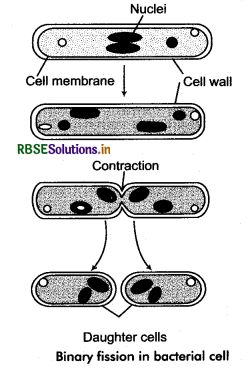

Question 14.
Classify bacteria on the basis of mode of nutrition.
Answer:
On the basis of mode of nutrition bacteria are of two types:
I. Autotrophic bacteria
II. Heterotrophic bacteria.
I. Autotrophic bacteria: They produce their own food.
They are of following types:
- Photosynthetic bacteria: They contain different types of pigments which produce food by the utilisation of light energy e.g., Chlorobium.
- Chemosynthetic bacteria: They produce food through various chemical reactions e.g., Bagiatoa.
II. Heterotrophic bacteria: They are of following types:
- Parasitic bacteria: They obtain their food from other organisms and are called parasites, e.g., Mycobacterium.
- Saprophytic bacteria: They obtain their food from dead and decayed organic substances, e.g., Bacillus mycoidies.
- Symbiotic bacteria: They form symbiotic association with higher plants, e.g., Rhizobium.
Question 15.
Write distinct characteristics of fungi.
Answer:
The distinct characteristics of fungi are as follows:
- They are predominantly multicellular (except Yeasts), non-chlorophyllous eukaryotic organisms.
- Due to absence of chlorophyll the modes of nutrition in fungi are heterotrophic and absorptive. The mode of nutrition may be saprophytic or parasitic.
- Cellwall composed of chitin is found in fungi. In some forms of fungi cellwall also contains fungal cellulose.
- Fungi has double envelope cellular organization.
- Fungi reproduce asexually as well as sexually. Sexual reproduction involves
- plasmogamy (fusion of cytoplasm)
- karyogamy (fusion of gametic nuclei) and
- meiosis.
- Fungi are mainly the decomposers and mineralisers of the biosphere. They play an important role in nutrients recycling.
Question 16.
Mention the differences between algae and fungi.
Answer:
Differences between algae and fungi
|
Algae |
Fungi |
|
1. They are chlorophyllous. |
1. They are non - chlorophyllous. |
|
2. They produce their own food by the process of photosynthesis. Therefore, they are autotrophs. |
2. They do not produce their own food. Therefore, they are heterotrophic or absorptive. |
|
3. Cellwall is made up of cellulose. |
3. Cellwall is made up of chitin and fungi cellulose. |
|
4. Food is stored in the form of starch. |
4. Food is stored in the form of glycogen. |
|
5. Mostly found in water or on damp soil. |
5. They found on dead and decayed substances or on living organisms. |
Question 17.
Mention the differences between viruses and bacteria.
Answer:
Differences between viruses and bacteria
|
Viruses |
Bacteria |
|
1. They are about 10 to 300 µ. |
1. They are about 2 µ to 10 µ. |
|
2. They possess the characteristics of both livings and non - livings. |
2. They possess the characteristics of livings. |
|
3. In them cellular structure is absent. |
3. They exhibit cellular organisation. |
|
4. They do not contain protoplasm and other cellular organelles. |
4. They contain protoplasm and other cell organelles. |
|
5. They contain DNA or RNA as genetic material. |
5. They contain both DNA and RNA. |
|
6. They remain active only inside the living host cell. |
6. They are free living, parasitic or saprophytic. |
Question 18.
Write salient features of viruses.
Answer:
- Viruses are non-cellular, ultramicroscopic, infectious particles.
- They are inert out side the living host cell. They are perfect obligate parasites (i.e., parasitic at the gene level) and cannot be grown on artificial culture media.
- They can be crystallised in the form of crystals.
- They are regarded as the connective link between living organisms and non - living objects.
- They are highly pathogenic and cause various infectius diseases in plants and animals.
- All viruses are nucleoproteins. The nucleic acid is protected by protein coat against attack by nuclease enzymes.
Question 19.
Give reasons why fungi should not be included in plant kingdom?
Answer:
Fungi differ from plants in their mode of nutrition, reserve food materials and composition of cellwalls. Due to the absence of chlorophyll fungi are heterotrophic organisms which obtain their food by absorption from the surrounding medium. They are decomposers and mineralisers of the bisophere. In fungi the reserve food material is glycogen and fat as in animals. The cellwall is composed of chitin and fungal cellulose. Therefore, fungi should not be grouped in plant kingdom.
Long Answer Type Questions
Question 1.
What is five kingdom system of classification. Mention basic features of five kingdom system of classification.
Answer:
R.H. Whittaker, an American ecologist proposed a five kingdom system of classification in 1969. The kingdoms defined by him were named Monera, Protista, Fungi, Plantae and Animalia. The main criteria for classification used by him include cell structure, body organisation, mode of nutrition, reproduction and phylogenetic relationships.
Basic features of Five Kingdom Classification:
1. Structure of Cells: Organisms can be divided into two major categories on the basis of cell structure:
- Prokaryotic cells: having incipient nucleus and
- Eukaryotic cells: having membrane bounded nucleus and cell organelles.
2. Body Organisation: The theory of organic evolution has revealed that the earliest organisms were simple unicellular. Some of the unicellular prokaryotic organisms in due course of time evolved into multicellular organisms. Some of the multicellular organisms finally became complex.
3. Mode of Nutrition: R.H. Whittakar classified organisms on the basis of autotrophic and heterotrophic mode of nutrition. Autotrophic mode of nutrition can be divided into chemosynthetic nutrition and photosynthetic nutrition. Heterotrophic organisms are also divided into two categories: holozoic or ingestive and saprotrophic or absorptive.
4. Phylogenetic Relationships: Evolutionary history of an organism is called phylogeny. Therefore, phylogenetic relationships of organisms alone are the index of their true kinship. Such relationships are not clear in all cases. Only fossil record can provide such relationships but this record is incomplete and is likely to remain so. Therefore, the phylogenetic relationships are ascertained from morphology, cytology, genetics, biochemistry and physiology for the correct classification of living organisms.
Question 2.
What is five kingdom system of classification. Mention drawbacks of five kingdoms system of classification.
Answer:
R.H. Whittaker, an American ecologist proposed a five kingdom system of classification in 1969. The kingdoms defined by him were named Monera, Protista, Fungi, Plantae and Animalia. The main criteria for classification used by him include cell structure, body organisation, mode of nutrition, reproduction and phylogenetic relationships.
Basic features of Five Kingdom Classification:
1. Structure of Cells: Organisms can be divided into two major categories on the basis of cell structure:
- Prokaryotic cells: having incipient nucleus and
- Eukaryotic cells: having membrane bounded nucleus and cell organelles.
2. Body Organisation: The theory of organic evolution has revealed that the earliest organisms were simple unicellular. Some of the unicellular prokaryotic organisms in due course of time evolved into multicellular organisms. Some of the multicellular organisms finally became complex.
3. Mode of Nutrition: R.H. Whittakar classified organisms on the basis of autotrophic and heterotrophic mode of nutrition. Autotrophic mode of nutrition can be divided into chemosynthetic nutrition and photosynthetic nutrition. Heterotrophic organisms are also divided into two categories: holozoic or ingestive and saprotrophic or absorptive.
4. Phylogenetic Relationships: Evolutionary history of an organism is called phylogeny. Therefore, phylogenetic relationships of organisms alone are the index of their true kinship. Such relationships are not clear in all cases. Only fossil record can provide such relationships but this record is incomplete and is likely to remain so. Therefore, the phylogenetic relationships are ascertained from morphology, cytology, genetics, biochemistry and physiology for the correct classification of living organisms.
Drawbacks of five kingdom system of classification:
- The kingdoms monera and protista are still heterogenous groups of organisms. Both include photosynthetic and heterotrophic organisms with cellwall and without cellwall.
- In this system of classification phylogenetic relationship particularly of lower organisms are not fully reflected, e.g., some green algae and some photosynthetic bacteria get hydrogen from sources other than H2O but these are grouped under different kingdoms.
- Each kingdom is polyphyletic. For example, many different protistian lives gave rise to multicellular group and none of the these higher kingdoms contains the single ancestor of all its members. Multicellular lives originated from protists many times.
- Unicellular green algae, such as Chlamydomonas, volvox have not been grouped in the kindgom protista due to their resemblence with the other green algae in structure, reproduction and pattern of life cycle.
- The slime moulds are quite different from the other protists with which they have been combined.
Question 3.
Mention the types of bacteria on the basis of shape and flagella.
Answer:
Cohn divided bacteria into following types on the basis of shape:
- Spherical or Coccus: The coccus bacteria (plural - cocci) are spherical ellipsoidal or avoid in shape, Coccus forms may exist singly (micrococcus) in pairs (diplococcus), in tetrads (tetracoccus), in chains (streptococcus). A few cocci may occur in cuboidal packets of 8 or more cells (Sarcina) or in sheets (staphylococcus).
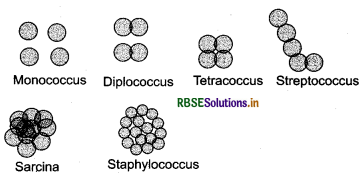
- Bacillus: The bacillus bacteria (plural - bacilli) are straight rod shaped or cylindrical bacteria. The end walls of bacterial cell may be pointed flat, concave or convex. The may exist singly (Bacillus) in pairs (Diplobacillus), like a stack (Palisade Bacillus) or in chains (Streptobacillus).

- Spirillum: They are spiral or coiled like a cork screw. The spirillum forms are usually rigid and bear two or more flagella at one or both the ends e.g., spirillum, spirochaete etc.
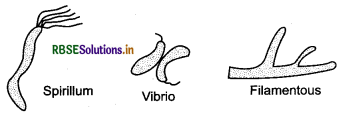
- Vibrio: The bacteria are rod shaped with single curve, C - shaped or comma shaped. Thy have one or more flagella at one end. e.g., vibria.
- Filamentous: The body of bacterium is filamentous. The filaments are very small e.g., Beggiatoa, Triothrix.
- Stalked: The body of bacterium possesses a stalk. e.g., Caulobacter.
- Budded: The body of bacterium is swollen at different places, e.g., Rhodomicrobium.

On the basis of number and mode of attachment of flagella on bacterial cell bacteria may be grouped under the following types:
- Atrichous: They lack flagella e.g., Lactobacillus.
- Monotrichous: Single flagellum is attached to one end of flagellum, e.g., Vibrio cholerae.
- Caphalotrichous: Many flagella are attached to one end of bacterial cell, e.g., Pseudomonas flacorescence.
- Amphitrichous: Single flagellum is attached at each of the two ends of bacterial cell e.g., Nitrosomonas.
- Lophotrichous: A group of flagella is attached at each of two ends of bacterial cell e.g., Spirillum volutans.
- Peritrichous: Flagella are attached all over the body e.g., Salmonella typhae, E. coli etc.
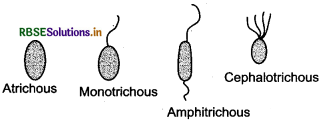
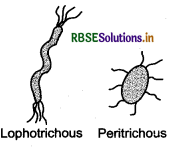
Question 4.
Describe the structure of Bacteriophage.
Answer:
The viruses which attack bacteria are called bacteriophages. A well studied bacteriophage which attack E. coli is called coliphage. The structure of a typical coliphage is shown below:
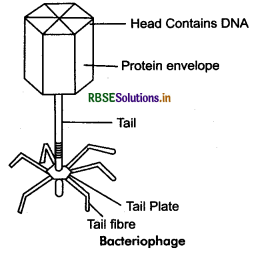
It is tadepole like virus consisting of a head and a tail of approximately equal length. The head is polyhedral in shape. It has an outer coat of protein enclosing a single molecule of DNA which is double helical, coiled and long. The tail is much narrower in comparision to head. It consists of 4 different kinds of protenaceous components forming a spiral sheath. The tail sheath protein is ontractile in longitudinal direction. The tail sheath bears a disc like hexagonal plate at its distal end. It bears six spikes to which are attached six tail fibres. There are about twenty five striations present across the tail.

Question 5.
Write down the main characteristics of kingdom Monera and Protista.
Answer:
Characteristics of Kingdom Monera:
It includes the most ancient, the smallest, the simplest and the most plentiful prokaryotes. Therefore, the kingdom monera is also called as prokaryota (gk, pro = before, kary = nucleus). These organisms lack a true nucleus and some basic proteins are absent in nucleoplasm.
The kingdom monera includes bacteria, cyanobacteria (blue green algae) and archaebacteria.
(a) Bacteria: They are minute, small, unicellular, microscopic, simple undifferentiated prokaryotes. They were discovered by Antony Van Leeuwenhoek (1632 - 1723) and called them animalcules (little animals). The name bacteria was given by Ehrenberg is 1838. Bacteriology deals with the study of bacteria.
Bacteria are found anywhere and everywhere in water, in air, in soil, in all organisms. Some thermophilic bacteria can withstand the temperature upto 18°C while some psychrophilic bacteria occur upto.the temperature of-190°C. The average size of bacterial cell ranges from 1 pm to 10 pm in length and from 0.7 pm to 1.5 pm in width. The smallest bacteria is cocci and largest bacterium is Biggiatoa mirabilis (diameter 16 - 45 p).
Bacteria are grouped under four categories based on their shape:
- Cocci: These bacteria are spherical, ellipsoidal or ovoid in shape. Coccus bacteria may exist singlely (micrococcus), in pairs (diplococcus), in tetrads (tetracoccus), in chains (streptococcus) or in sheets (staphylococcus).
- Bacillus: The bacillus bacteria are straight rod shaped or cylindrical. The end walls may be pointed, flat, convex and concave. They may exist singlely (Bacillus), in pairs (Diplobacillus), like a stalk (Palisade Bacillus) or in chains (Streptobacillus).
- Spirillum: They are spiral or coiled like a cork screw. The spirillar forms are usually rigid to bear two or more flagella at one or both the ends. For example, Spirillum, Spirochaete etc.
- Vibrio: These bacteria are rod shaped with single curve, C shaped or comma shaped. They have one or more flagella at one pole e.g., Vibrio.
Characteristics of Kingdom Protista:
Kingdom protista includes all unicellular eukaryotic microorganisms (Except unicellular algae e.g., Chlamydomonas, Chlorella etc., fungi e.g., yeasts etc). Usually, they live as solitory cells but a few forms may develop colonies of same cells. They are predominantly water dwelling (aquatic). Kingdom protista acts as a connective link between kingdom monera and fungi, plants and animals. The protists are regarded as ancestors of all multicellular eukaryotes. Being eukaryotes the protistian cell body contains a well defined nucleus and other membrane bound organelles. Some have flagella or cilia. Protists reproduce asexually and sexually by a process involving cell fusion and zygote formation. These organisms exhibit photosynthetic (holophytic), holozoic, saprophytic, parasitic and mixotrophic mode of nutrition.
Unicellular protists have been broadly divided into following groups:
- Chrysophytes
- Dinoflagellates
- Euglenoids
- Slime moulds
- Protozoans.
Question 6.
Write short notes on the following:
(a) Phycomycetes
(b) Ascomycetes
(c) Basidiomycetes
(d) Deuteromycetes.
Answer:
(a) Phycomycetes:
Members of class phycomycetes are found in aquatic habitats and on decaying wood in moist and damp places or as obligate parasites on plants. The mycelium is
aseptate and coenocytic. Asexual reproduction takes place by zoospores (motile) or by aplanospores (non-motile). These spores are produced in sporangium endogenously. Fusion of two gametes leads to the formation of zygospore which is diploid (2n) in nature. These gametes are isogamous (morphologically alike) or anisogamous (morphologically disimilar). Some members of phycomycetes are Mucor, Rhizopus (bread mould) and Albugo (the parasitic fungi on mustard) etc.
(b) Ascomycetes:
The members of this class are called sac fungi. It is a large group with over 30,000 species include brown, green, blue and pink moulds, powdery mildews, cup fungi, yeasts, morels and truffles. Most of them are terresterial and occur as saprotrophs or as parasites. The parasitic forms cause diseases in plants e.g., powdery mildews, ergots etc. The yeasts are unicellular simplest sac fungi. Except yeasts all ascomycetes are mycelial. The mycelium is well developed and branched. The hyphae are septate and multicellular. The ascomycetes are characterised by complete absence of motile structures in their life cycle. Yeasts usually reproduce asexually by the formation of conidia or conidiospores. They are produced exogenously mostly in chains from the tips and sides of hyphae.
Sexual fusion occurs by gametic copulation (e.g.. yeasts), gametangial contact (e.g., Pyronema), sepermatization (e.g., Ascobolous carbonarius) and somatogamy (e.g., Deziza). Sexual reproduction takes place in three phases plasmogamy, karyogamy and meiosis. Plasmogamy results in the formation of dikaryon consists of dikaryotic cells which act as ascus mother cell. In this cell the two nuclei of opposite mating types fuse (karyogamy) to form diploid ascospores which remain inside the ascus (sac like structure). The asci are club shaped, elongated, ovoid or rectangular in shape. The ascospores are liberated from ascus and germinate to produce new mycelia. Examples are Yeasts, Aspergillus, Penicillium, Neurospora, Claviceps, Morels and Truffles.
(c) Basidiomycetes:
It is a most advanced and largest group of higher fungi with about 1100 genera and 25,000 species. Commonly known as rusts, smuts, mushrooms, puffballs, toad stools, sting horns, bracket fungi etc. Due to presence of large fruiting bodies (basidiocarps) they are the most common fungi. Some produce edible fruiting bodies e.g., mushrooms, some produce extremely poisonous chemical substances. They decompose the wooden materials.
The mycelium of basidiomycetes is composed of filamentous, branched and septate hyphae. The mycelia are of three types:
- Primary mycelium
- Secondary mycelium and
- Tertiary mycelium.
- Primary mycelium develops from uninucleate haploid basidiospores and consists of uninucleate cells. It multiplies by conidia.
- Secondary mycelium consists of binucleate cells. It grows with cell division which is accompained by clamp connection to facilate proper distribution of dikaryons. It multiples by the formation of different types of spores such as, chlamydospores, uredospores, teleutospores and a aeciospores etc.
- Tertiary Mycelium: It is associated with the basidiocarp formation around the basidia. Its hypae are also dikaryotic like the secondary mycelium.
(d) Deuteromycetes:
These are commonly known as fungi imperfecti because only the asexual vegetative phases of these fungi are known. When the sexual forms of these fungi were discovered they were named into classes they rightly belong to. This class include about 1680 genera and 17000 species.
They are saparophytic in soil and grow on decaying matter. Most of them are parasites and cause serious diseases in plants, animals and humans. Hyphae are well developed, branched and septate.
Reproduction occurs only by asexual methods by the formation of conidia. The conidia are directly produced on condiophores or in sporodochia, pycnidia, acervuli and synnemata. Sexual reproduction is either absent or not reported. Examples are Alternaria, Colletotrichum, Fusarium, Trichoderma etc.

- RBSE Solutions for Class 11 Biology Chapter 10 Cell Cycle and Cell Division
- RBSE Solutions for Class 11 Biology Chapter 9 Biomolecules
- RBSE Solutions for Class 11 Biology Chapter 8 Cell: The Unit of Life
- RBSE Solutions for Class 11 Biology Chapter 7 Structural Organisation in Animals
- RBSE Solutions for Class 11 Biology Chapter 6 Anatomy of Flowering Plants
- RBSE Solutions for Class 11 Biology Chapter 5 Morphology of Flowering Plants
- RBSE Solutions for Class 11 Biology Chapter 4 Animal Kingdom
- RBSE Solutions for Class 11 Biology Chapter 3 Plant Kingdom
- RBSE Solutions for Class 11 Biology Chapter 2 Biological Classification
- RBSE Solutions for Class 11 Biology Chapter 1 The Living World
- RBSE Solutions for Class 11 Biology Chapter 5 पुष्पी पादपों की आकारिकी